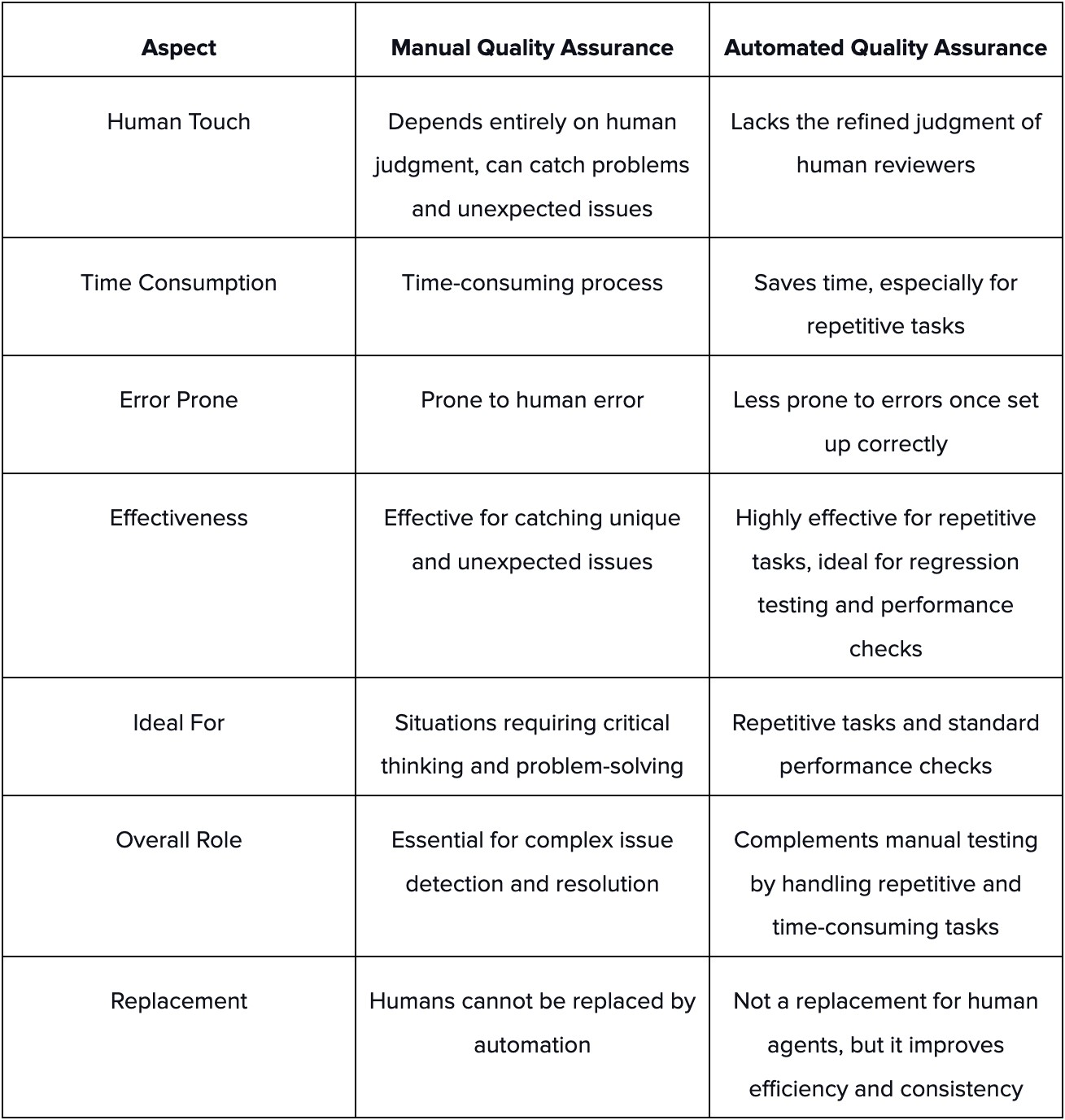Do you prioritize the importance of quality service, especially in customer service? If so, you must understand customer service quality assurance (QA), essential for any business. It assures your customers are happy with the help they get. When you meet their expectations, it can increase your business. This assurance makes customers happy and loyal and helps you find ways to improve how you help people.
This blog will explore the key strategies and tools to help you elevate your customer service game. Let's get started.
What is Customer Service Quality Assurance (QA)?
Quality assurance checks that your products and services meet your client's expectations and industry standards. It's about ensuring everyone in the team helps customers in the best way possible. QA checks how your team or AI (artificial intelligence) talks to customers, what they say, and if they follow the right steps to solve users' problems. Through this method, a business gets valuable insights to improve more and turn normal users into lifelong customers.
Why is Quality Assurance Important in Customer Service?

Quality assurance in customer service is part of business success. Good service can lead to positive results, including sales increases and customer retention. A study by Mindful shows that 70% of customers return if they have a positive experience. Conversely, poor service drives customers away, with 59% willing to leave after bad experiences.
When users get a unified customer experience, they recommend a brand to friends and family. By focusing on quality, a business fixes problems and turns customer service into a growth engine.
Benefits of Customer Service QA
QA is the backbone of customer service, and it has many benefits. Let's examine the ways it can elevate your business.
Performance Visibility: Visibility of your agent's performance is part of this quality assurance. Omind provides data-driven insights that offer a clear view of agent performance, making it easier to identify top performers and areas needing support. Here, you can identify top performers and pinpoint areas where training or support is required. This data helps you recognize and reward high-performing agents.
Career Growth: This process shows your staff where they can improve and what they're doing great. Regular feedback based on QA results can improve morale, motivation, and overall job satisfaction.
Customer Satisfaction: Your customers will be happy when you focus on quality more and help find new ways to improve it. By addressing issues promptly and effectively, you can increase customer loyalty, advocacy, and lifetime value.
Identifying Improvements: Customer service quality assurance helps you with improvement opportunities. Analyzing customer feedback reveals trends and makes data-driven decisions to improve your service and gain a competitive edge.
Streamline Processes: When you know how issues are handled, you can find ways to make your support process more efficient. It saves lots of time and money. This process helps a firm identify bottlenecks and redundant steps, improving productivity and customer satisfaction.
Customer Churn Reasons: Understanding why customers leave may help you stop that. QA is a method that uncovers patterns and trends that point to underlying issues. If you address them, you can reduce client churn and improve retention rates.
Faster Onboarding: Having data on quality can help with training and speed up the onboarding process. It reveals the common challenges new hires face and helps you address them effectively, reducing time to productivity.
Effective Coaching: With insights from QA, a company may go with targeted coaching that helps agents improve specific skills. Omind offers actionable insights that can significantly aid in crafting personalized coaching plans. Regular coaching based on QA data can lead to significant performance improvements and increase agent confidence.
Measuring Quality: QA must ensure that quality standards are met when outsourcing customer service. Regular QA checks can help you monitor performance, find areas for improvement, and adhere to service-level agreements.
Let's dig deeper into the core metrics that drive excellent customer service.
The Role of Customer Service QA Metrics
Metrics have a greater role in customer service quality, and they give you data to improve your team's performance. Let's explore different types of metrics and how to use them.
The metrics are valuable because they tell you how customers perceive your service. However, they have limitations as they only tell part of the story. Factors beyond your agent's control can influence these metrics and might not provide detailed insights into specific performance areas. See some of the famous external metrics used.
SAT (Customer Satisfaction)
NPS (Net Promoter Score)
CES (Customer Effort Score)
It's crucial to combine external and internal evaluations for an overall view. External metrics show overall customer sentiment, while internal metrics like quality scores can pinpoint areas for improvement within your team.
Internal Quality Score (IQS): An Internal Quality Score (IQS) measures how well your agents adhere to your service standards. It's based on evaluations of recorded calls or chats using specific quality criteria. IQS identifies strengths and weaknesses, provides targeted feedback, and recognizes top performers. An Internal Quality Score (IQS) measures how well your agents adhere to your service standards.
We have seen how the role of metrics. Now, let’s look at the implementation of QA.
Implementing and Improving Customer Service QA

A strong service quality assurance process is essential to deliver exceptional experiences. Explore some of the steps below.
Vision and Goals: Before you dive in, clearly outline your support vision. What kind of experience do you want customers to have? Once you have a clear picture, set specific, measurable, achievable, relevant, and time-bound (SMART) goals for your support team.
Communication with the Agents: Your agents play an excellent role in this role. Communicate openly and clearly explain the QA process to your agents. Explain to them that it is a tool for improvement, not punishment. Address concerns and questions openly.
QA Scorecards: Develop a scoring system that connects with your support goals. Categories might include product knowledge, problem-solving, tone, active listening, and script adherence. Ensure these categories are specific and understandable.
Choose Review: Decide how frequently you review interactions and which channels to focus on, such as phone, email, chat, and social media. Use random sampling or prioritizing based on customer satisfaction scores or agent performance.
Calibration Sessions: Regularly calibrate your QA team to ensure consistent scoring. This involves listening to calls together and discussing evaluations. Calibration helps maintain standards and prevents scoring bias.
Now, let's explore how you can create a solid QA program.
Creating a Customer Service QA Program
Choosing a customer service quality assurance program is like building a strong foundation for your team. It ensures everyone is on the same page and delivers maximum support.
Start by identifying what your team stands for. What kind of service do you want to provide? Is it friendly, helpful, and efficient? Clearly guide your team and set the tone for every customer interaction.
You'll need someone to look after this process. This could be a specialist or a small team. They'll evaluate customer interactions and provide feedback.
It is not possible to review every single interaction, so pick the right ones. Focus on calls or chats with specific issues, new agents, or high-value customers.
As your business grows, so will your customer interactions. Your QA process needs to keep up. Find ways to automate daily tasks with technology. Omind's AI capabilities can help automate your QA process, making it more efficient.
Once your program is in place, it's all about using QA to coach your team to success.
Using QA to Coach Your Team
QA is a tool to help your team grow. Using these insights, an organization can coach your team to become better professionals.
Think of the results as a roadmap for improvement. Platforms like Omind directly translate detailed insights into effective coaching strategies. When you find areas where you are struggling, use it as an opportunity to provide targeted coaching. Focus on specific behaviours or skills that need improvement. Regular one-on-one coaching sessions may help you understand their strengths and weaknesses and create a growth plan.
The results also show trends and patterns across the team. If you notice a common issue, it might be time for team-wide training or process improvements. The findings can be shared with the entire team, creating a culture of continuous learning and improvement.
It's also important to carefully select which customer conversations to review for optimal insight.
Selecting Customer Conversations for Review
Picking the proper interactions can contribute a lot to your QA program. There are many advantages to it.
Representative Samples
Reviewing a mix of customer interactions gives you a clear picture of your team's performance. Don't look at only easy calls; you might miss areas that need improvement. A good sample includes calls with diverse difficulty levels, different types of customers, and different outcomes.
Choosing Strategy
A company can use conversations for review in several ways. It can pick calls at random, focus on specific agents, or target interactions with certain customer segments. A combination may work better. For instance, it might randomly select 20 calls a week and then add five calls from each new agent.
Balancing Random and Targeted Reviews
Random sampling gives a broad overview, but targeted reviews can help you focus on specific areas. For example, a business launching a new product might want to review calls related to that product to see how its team is handling customer inquiries. Finding the right balance between random and targeted reviews will give you valuable insights.
Automated vs. Manual Quality Assurance
Manual and automated quality assurance are like two sides of the same coin. Both are important for ensuring satisfaction and providing a unified customer experience.

But when is it the right time to switch to QA software? Let's find out.
When should you switch to customer support QA software?
Spreadsheets are a starting point for basic QA, but they quickly become overwhelming. They lack automation, advanced filtering, and reporting capabilities. Quality assurance software offers dedicated features for efficiently analyzing interactions and giving a unified customer experience.
Indicators for QA Software
If you're struggling to manage and analyze many customer interactions.
If your team is spending more time on manual data entry and analysis.
If your current method is providing inconsistent reports,
If you're not able to identify trends or patterns in customer interactions.
Advantages of QA Software
It can streamline processes like data import, scoring, and reporting.
Easily segment data based on various criteria (agent, team, customer, etc.).
The software generates detailed reports and visualizations to identify trends.
It uses advanced analytics like AI to uncover hidden insights.
Finally, let's review a handy checklist for managers to ensure top-notch QA.
Customer Service QA Checklist for Managers

The managers need a checklist to test customer service quality assurance. Let's see them now.
Soft Skills
Grammar and spelling: Check for correct usage and clarity.
Tone: Check if the agents use a professional and friendly tone with the customers.
Empathy: Assess the agent's ability to understand and respond to customer emotions.
Issue Resolution
Effectiveness: Check whether the agent successfully resolved the customer's issue.
Clarity: Are the agents explaining the solution clearly and concisely?
Product knowledge: Assess the agent's understanding of products or services.
Support Procedures
Productivity: What is the agent's efficiency in handling customer inquiries?
Compliance: Ensure adherence to company policies, procedures, and regulations.
Privacy policies: Verify the protection of customer data and ensure adherence to privacy laws.
Conclusion
If you value your customers and want to retain them with your product and service, you should prioritize Customer service quality assurance. This quality program will help a business identify strengths, weaknesses, and opportunities for improvement within its team.
If you need a partner to ensure quality, you can choose a provider like Omind, which can revolutionize your customer service QA process with sophisticated technology like automation and CSAT. With its powerful AI and data analytics, Omind transforms interactions into actionable insights. Identify trends and coach agents effectively to improve customer experiences (CX).
Ready to start revolutionizing your QA process? Try Omind today to redefine your customer service.
AUTHOR
Team Omind
Empowering Businesses with Unified Customer Experience Platform, Leveraging Advanced AI and Intelligent Automation
PRODUCT
QMS
Share LINK
Related Blogs




